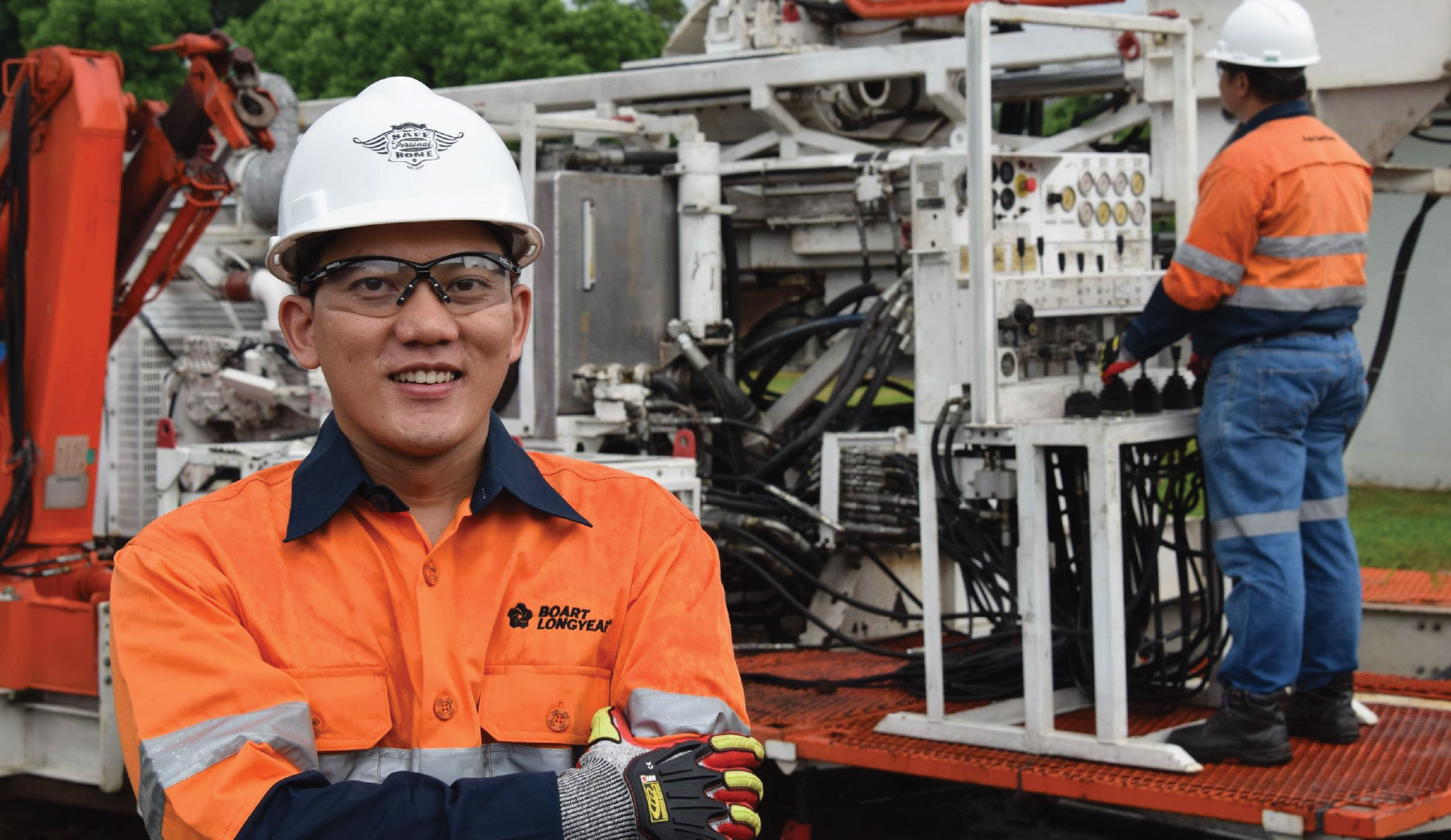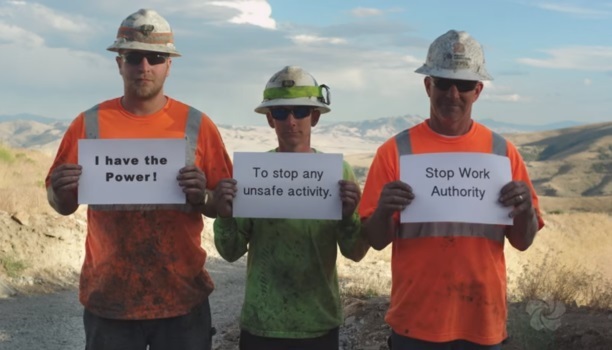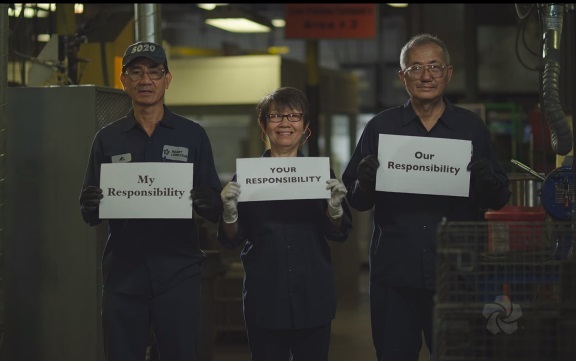SÉCURITÉ
4 octobre 2018
La responsabilité de l'autorité de travail d'arrêt
Des routes poussiéreuses de Winnemucca, au Nevada, à un camp d'hommes isolé dans le désert d'Atacama et au-delà, le forage d'exploration est l'une des dernières grandes aventures de l'humanité.
Les exercices sont conduits, pilotés et transportés à la main dans des endroits éloignés pour aider à découvrir et à définir des ressources précieuses. Les équipes de forage quittent leurs familles et la sécurité de la technologie moderne pour aider à la recherche de la prochaine grande grève. La satisfaction de faire partie d'une image plus globale est incroyablement enrichissante, mais rien n'est plus gratifiant que de rentrer chez soi et de partager l'aventure avec ses amis et sa famille. Faire partie d'une équipe d'exploration nécessite une formation approfondie, des connaissances et une grande confiance. Dès le premier jour d’emploi, les membres de l’équipe sont formés aux procédures opérationnelles appropriées et à la sécurité de chaque tâche qui leur est confiée. Ils développent des connaissances à partir de chaque projet qu'ils terminent, développant ainsi un large éventail de compétences et la capacité de résoudre des problèmes sur site.

Au fil des années, l'employé passe de novice à vétéran, offrant des années d'expérience pour mener à bien les projets les plus exigeants. Dans l'industrie du forage, plus un employé a d'expérience, plus il devient inestimable. La formation est la base et les connaissances créent la structure d'un excellent membre de l'équipe, mais la confiance est ce qui permet à tous les projets d'avancer vers l'objectif final. Les nouveaux employés aux anciens combattants âgés de 20 ans ont confiance en leur capacité à opérer en toute sécurité. Si un membre de l'équipe voit un acte dangereux, il dira «STOP» avant que cet acte ne devienne potentiellement un incident. Boart Longyear utilise l’autorité Stop Work qui permet à tous les membres de l’équipe, quelle que soit leur ancienneté, d’arrêter de travailler chaque fois que la situation est dangereuse. . Le fait de savoir que vos collègues vous soutiennent et que vous avez le leur permet un travail sûr et productif. Une utilisation appropriée du responsable des travaux d’arrêt maintient un chantier sûr; Pourtant, il y a des moments sur chaque projet où quelqu'un aurait dû dire «STOP», mais cela ne s'est jamais produit. Qu'est-ce qui empêche un employé de s'exprimer? Explorons trois scénarios de sécurité émanant de différentes entreprises et projets du monde entier, susceptibles d'aider les employés à s'exprimer.
Man up!
Le forage nécessite des employés qui sont durs mentalement et physiquement. Ce travail requiert des hommes et des femmes capables de travailler dans une large gamme de conditions météorologiques, en accomplissant des tâches exigeantes telles que faire trébucher un tuyau ou manipuler un tubage. Dans le passé, lorsqu'un travail devient trop difficile à mener à bien, les autres membres de l'équipe crient «Man up» ou d'autres mots d'encouragement indésirables. Dans le cadre d’un projet de puits de protection cathodique dans l’ouest du Texas, deux membres de l’équipe ont tenté d’enlever un tricone de 12 pouces d’un stabilisateur pendant que l’outillage se trouvait dans la table. Après plusieurs tentatives infructueuses de dévissage du foret, l’employé A a demandé à l’employé B d’utiliser le tuyau en aluminium de 48 po sur la table. L'employé B savait que la clé était le mauvais outil pour le travail et, comme il commençait à l'expliquer, l'employé A a déclaré: «Bon sang, arrêtez d'avoir peur. B au-dessus de l'œil gauche nécessitant 18 points de suture. Deux autres membres de l’équipe ont assisté à l’ensemble de l’événement sans se plaindre ni dire «STOP». Le forage est un travail rude et difficile dans lequel personne sur le site ne veut avoir l’air faible. Cependant, c’est ainsi que les accidents risquent de devenir fatals. Tous les membres de l’équipe sur place avaient reçu la formation appropriée pour dire: «Arrêtez-vous. C'est un mauvais outil pour le travail. »Une bonne culture de sécurité commence par éliminer les méthodes de fonctionnement« man up »et les remplace par des membres de l'équipe qui se font confiance. Les membres de l’équipe qui sont prêts à parler quand une procédure est dangereuse. Un homme en haut peut rapidement devenir un homme en bas lorsque personne ne le dit.
Le patron sait le mieux
Le forage est une compétence développée au fil des années. le foreur sur place a souvent trois fois plus d'expérience que le nouvel employé. Sur un projet de carottage dans le désert d’Atacama, une équipe de forage préparait la plate-forme pour leur troisième trou de 1 000 mètres. Le foreur a fixé le tuyau de boue à la pompe et s'est préparé à commencer à pomper le fluide de forage. Plusieurs heures après le premier quart de travail du nouveau trou, la ligne de boue a soufflé sur la pompe, heurtant un assistant et le jetant au sol.
L'assistant a subi une petite lacération et des ecchymoses. Une enquête sur l'accident a révélé que le câble de sécurité de vérification du fouet n'était pas fixé conformément à la procédure d'utilisation standard. Un employé sur place a déclaré qu'avant de rejoindre son nouvel équipage, ils avaient toujours branché le câble, mais que son nouveau foreur et son nouvel équipage n'avaient pas attaché les câbles aux deux trous précédents. L'employé a pensé que le foreur savait mieux que quiconque pour son appareil de forage et n'a pas pris la parole. Les projets sûrs sont les plus efficaces, et la sécurité dépend du respect des procédures appropriées à chaque fois. Tous les employés sur place auraient dû dire «STOP» aux premier et deuxième trous lorsque le câble de sécurité n'était pas attaché.
Les distractions du 21ème siècle
Le forage est un processus complexe nécessitant que chaque membre de l'équipe sur place se concentre sur les tâches à accomplir.
Le forage est un processus complexe nécessitant que chaque membre de l'équipe sur place se concentre sur les tâches à accomplir. Les outils en rotation, les fraisiers suspendus, les glissades, les trébuchements et les chutes ne sont que quelques exemples des dangers à résoudre lors du travail autour d’une foreuse. Sur un projet de construction situé aux abords du centre-ville de Toronto, une équipe de deux personnes a foré des trous de tarière de 6 ”à 17 mètres. Les deux avaient travaillé ensemble pendant plus de dix ans sur des projets similaires à travers le Canada. C’était un mardi matin pluvieux et l’équipe avait cinq trous à compléter pour la journée. L'équipe changerait de rôle de foreuse à assistante après chaque trou, permettant ainsi à l'employé A et à l'employé B de travailler aux deux postes. Après le deuxième trou, l'employé A a remarqué sur les médias sociaux sur son smartphone qu'un membre de la famille avait été blessé dans un accident de voiture. Au fur et à mesure que l'équipe progressait vers le trou trois, l'employé B forait, alors que l'employé A préparait les vrilles. L'employé B pouvait dire que l'employé A n'était pas lui-même, mais ils continuaient à travailler. Au moment où ils ont connecté la dernière vis, l’employé A a mis sa main sur la tête pendant que l’employé B était encore en train de percer et que l’employé A s’écrasait le petit doigt et l’annulaire. Lorsqu'on a demandé à l'employé A ce qui s'était passé et pourquoi il mettrait sa main à un point de pincement, il était perdu. Il a ensuite expliqué que les photos de l'accident de voiture sur les médias sociaux l'avaient fait penser à sa famille et non au travail. Les téléphones intelligents nous permettent d’être au courant des situations en un instant. Grâce à cette technologie, nous pouvons être physiquement sur le chantier et mentalement ailleurs. L’employée B a déclaré lors de l’enquête sur l’accident qu’elle savait que quelque chose ne va pas, mais qu’elle n’a pas pris la parole. Après coup, l’employée B a déclaré qu’elle aurait dû fermer la plate-forme et laisser l’employé A prendre le temps de connaître la gravité du membre de la famille blessé. Le responsable des arrêts de travail est conçu pour mettre un terme aux actes dangereux, et parfois cet acte permet de vérifier que son collègue est en sécurité mentale.
Leçon apprise
Personne ne commence la journée de travail avec l'intention d'être dangereux ou blessé.
Dans chaque scénario, il y avait un moment où un accident aurait pu être évité en disant «STOP». Personne ne commence la journée de travail avec l'intention d'être dangereux ou blessé. En général, les accidents sont dus à un manque d’entraînement, à un manque de jugement, à de la complaisance ou à une distraction. Certains employés s'inquiètent de ce moment embarrassant d'arrêter un collègue ou de se tromper en arrêtant un collègue. Le moment d'inconfort qui pourrait survenir en disant «STOP» est un sentiment de courte durée, comparé au souvenir de savoir que vous auriez pu arrêter l'acte dangereux avant que votre collègue ne soit blessé ou tué. Ce sentiment inconfortable est bien mieux que de dire «Je suis désolé» à la famille d’un employé blessé ou décédé. Stop Work Authority a été créé pour prévenir les événements catastrophiques et informer tout le monde sur le site. Aucun membre de l'équipe ne sera mécontent de l'utilisation inutile d'une autorisation d'arrêter des travaux. Si cette situation se produit, le moment est idéal pour informer l'équipe de la tâche et des risques encourus. Le niveau de risque augmente en fonction de la distance au centre de traumatologie le plus proche. La médecine moderne a considérablement augmenté les chances des patients de se remettre complètement d'une blessure catastrophique. Un travailleur qui écrase sa main sur un chantier du centre-ville de Los Angeles a une excellente chance de se rétablir complètement. Cependant, un travailleur sur une plate-forme centrale dans les monts Cascade a moins de 50% de chances de conserver l'appendice, sans parler de retrouver sa mobilité. Les progrès médicaux n’ont d’incidence que si les blessés peuvent être traités immédiatement par un centre de traumatologie ultramoderne. Dire «STOP» est toujours la bonne décision.
Être un employé de Boart Longyear, c'est savoir que la sécurité est une valeur fondamentale. Le but ultime de chaque projet est de ramener les membres de l'équipe à la maison en toute sécurité. Stop Work Authority fonctionne en raison de la confiance de l'équipe en l'autre. Cela crée un filet de sécurité secondaire permettant à tout le monde sur le site de pouvoir arrêter avant qu'un accident ne devienne catastrophique. L’utilisation et l’exécution correctes de l’autorité Stop Work proviennent de la formation, des connaissances et de la confiance. Toutes les personnes qui travaillent sur un chantier Boart Longyear sont les bienvenues et sont priées de s'exprimer lorsqu'elles voient une tâche dangereuse. Stop Work Authority est un outil puissant qui crée une culture de sécurité en évolution qui s’améliore activement chaque jour.
TELECHARGEZ LA CARTE STOP WORK AUTORITY
Téléchargez la carte de poche Boart Longyear Make it Safe, Make Personal, Make It Home avec la stratégie Stop Work Authority que chaque employé de Boart Longyear signe, ajoute une photo et emporte avec lui.
TÉLÉCHARGER
[pardot-form height="770" id="4199" title="Download Stop Work Authority"]
Permission de média: Si vous souhaitez republier cet article sur votre site web ou sur support papier, veuillez contacter marketing@boartlongyear.com pour permission. Nous sommes heureux que vous partagiez nos articles, et nous vous demandons seulement de citer Boart Longyear comme source et de fournir un lien, le cas échéant.





